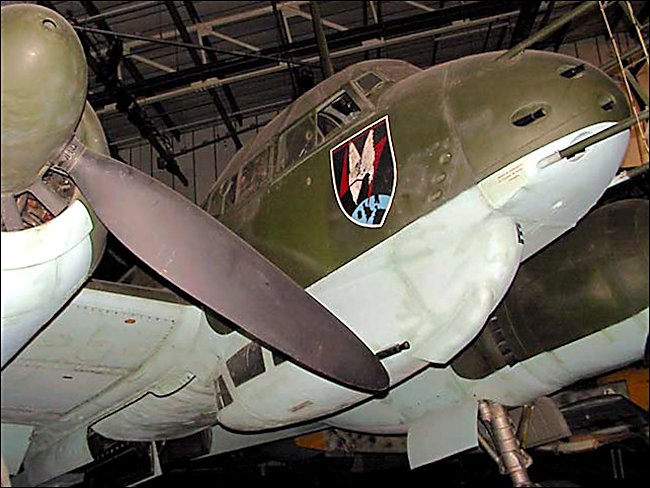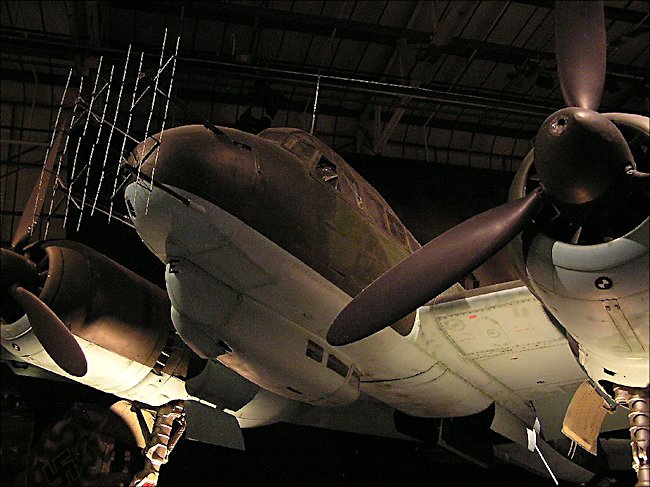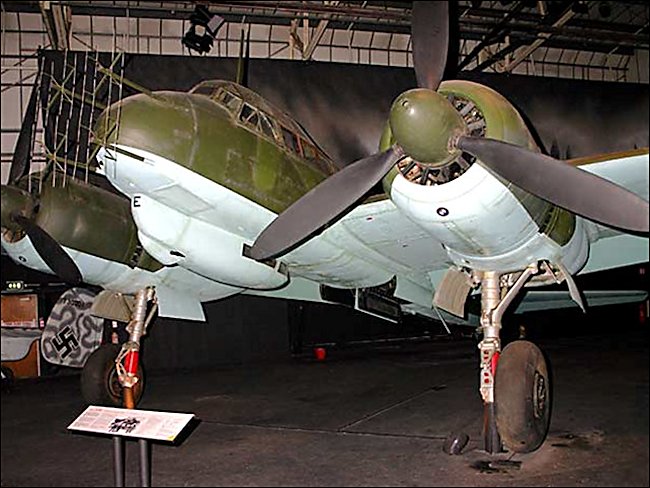Junkers JU88 Bomber
When the Junkers JU88 prototype flew in 1936 it got Hermann Goring jumping up and down with joy as its top speed was 360 mph (580 km/h). This was faster than most of the opposition's 1930 era biplane fighters. It could in theory bomb the target and get home fast and out run any fighters sent up to intercept it. But before it went into full production lots of extras were added that increased the JU88's weight reducing the maximum speed to only 280mph (450mph). The German Luftwaffe's dream of having a "Schnellbomber" a quick daylight bomber ended. Though saying that it was still faster than the other two main German bombers the Heinkel He111 and Dornier Do17.
The World War Two German Luftwaffe Junkers JU88 twin-engine combat aircraft began its life as a bomber but then became a night fighter intruder. It flew long range reconnaissance missions. The Junkers 88 was used successfully as a dive bomber, torpedo bomber on anti-shipping patrols, heavy fighter, and even as a flying bomb during the closing stages of conflict

Photograph taken at the RAF Museum, Hendon, London NW9 5LL England
A number of Ju 88 G1 airframes were converted to act as the warhead portion of the Mistel 2 flying bomb. The cockpit section was replaced by a bolt-on shaped charge warhead. A Focke-Wulf Fw190 was mounted above the pilotless Junkers 88 airframe to guide it towards the target before being released at the very last moment.
It was produced from 1936 to the end of the war in 1945. Between 15000 - 16000 Junkers 88's were built. There were lots of different variants but the basic design stayed the same. Changes were made to the initial design. The wings were strengthened, dive brakes were added, the fuselage was extended and the number of crewmembers was increased from three to four. Due to these advances, the Ju 88 was to enter the war as a medium bomber. It had a range of 1,429 miles (2430km) and a service ceiling without bombs of 29,500 feet (9,000 meters). It was armed with one 7.92 mm MG 81J machine gun on flexible mount in front windscreen, firing forward with 1,000 rounds, two 7.92 mm MG 81J on flexible mounts in back of the cockpit firing to the rear with 1,000 rounds each and one 7.92 MG 81Z twin machine guns in the gondola under the cockpit firing to the rear with 3,000 rounds in total. Different variants carried other armament options including cannons.

Photograph taken at the RAF Museum, Hendon, London NW9 5LL England
The Ju88 never saw service in the Spanish Civil War unlike the Hinkle 111 Junkers JU88's were planned for German Luftwaffe service introduction in 1938, but it finally entered Luftwaffe squadron service, with only 12 aircraft on the first day of the attack on Poland in 1939. Production was very slow with only one Ju 88 manufactured per week due to technical problems. The Erprobungskommando 88 (Ekdo 88) unit attached to 1./Kampfgeschwader 25 . There were given the job of testing new bomber designs and their crews under hostile conditions. The Junkers 88 did not play a big role in Polish campaign.
As a dive bomber the Ju88's airframe was found not to be up to taking the stress even with strengthening of the wings. Stress fractures had been found on a number of airframes. Some wings had collapsed during dives causing the death of the crews. In 1943 the dive brakes were taken off and a new bomb sight added to enable it to dive at a shallower angle and then release bombs. For the time it was reasonably accurate. It was able to deliver a bomb load of 3,310-4,410 lb (1,500-2,000 kg) bombs.

Photograph taken at the RAF Museum, Hendon, London NW9 5LL England
In the Battle of Norway Junkers JU88 sunk HMS Gurka and damaged HMS Rodney. In the invasion of France Junkers JU88's claimed just under 250 allied aircraft destroyed on the ground. It was targeted with dive bombing operations on strategic locations like railway junctions, airfields, bridges, fuel dumps and supply depots. JU-88's sunk a the ocean liner RMS Lancastria, off Saint-Nazaire, killing some 5,800 Allied personnel.
The Junkers JU88 played a major role in the Battle of Britain and the Blitz. It was tasked with daylight raids on the British RADAR stations, Airfields and ports. Although the JU88 held its own in Poland and France it was vulnerable to the British hurricane and Spitfire fighters as it could not match their speed and maneuverability. It also lacked defensive armour and adequate armament to deal with ground fire and the areal threat from the RAF. Later models were fitted with three MG machine guns mounted in a new solid nose, as well as a 20mm Cannon, and two MG15 machine guns able to be fired from the fuselage. This helped make the Ju88 almost a fighter rather than a bomber. With divebreaks brought in the JU88 could dive 700km/h.During the Battle of Britain some of this big Ju 88 bombers escaped the spitfires by diving like this.

Photograph taken at the RAF Museum, Hendon, London NW9 5LL England
On the Eastern Front in Russia most of the German bomber units were now equipped with He 111 and Junkers 88s. The Ju 88 proved to be a very capable and valuable aircraft. They met with instant success by attacking enemy airfields and troop positions at low level and causing enormous damage for little losses in return
The tank destroyer P-2 version of the Junkers JU88 had two 3.7 cm BK 37 guns, whose higher muzzle velocity proved useful against the Russian tanks in the Eastern Front. This aircraft was used by Erprobungskommando 25. The Ju 88 P-3 added further armor for the crew, and was delivered at one wing (Staffel) of the Nachtschlachtgruppen 1, NSGr 2, NSGr 4, for night attacks in the Eastern Front, in northern Norway (NSGr 8) and Italy (NSGr 9)
Junkers JU88 Variants
Junkers Ju 88V-1 - Prototype Model; three seat crew compartment; fitted with Daimler-Benz DB600A V-12 1,000hp engines; total of ten prototype produced.
Junkers Ju 88A-0 - Pre-Production Model Designation
Junkers Ju 88A-1 - Initial Production Models; Series A Subvariant.
Junkers Ju 88A-2 - Series A Subvariant; fitted with rocket-assisted take-off.
Junkers Ju 88A-3 - Series A Subvariant
Junkers Ju 88A-4 - Series A Subvariant; Fitted with Junkers Jumo 211J-1 or Junkers Jumo 211J-2 class engines; increased wingspan; reworked and strengthened landing gear.
Junkers Ju 88A-5 - Series A Subvariant; similar to the Ju 88A-4 model series.
Junkers Ju 88A-6 - Series A Subvariant; fitted with a balloon cable fender.
Junkers Ju 88A-6/U - Long-Range Maritime Bomber; fitted with FuG 200 search radar and applicable equipment.
Junkers Ju 88A-7 - Series A Subvariant
Junkers Ju 88A-8 - Series A Subvariant
Junkers Ju 88A-9 - Series A Subvariant; tropicalized version of the Ju 88A-1 model series.
Junkers Ju 88A-10 - Series A Subvariant; tropicalized version of the Ju 88A-5 model series.
Junkers Ju 88A-11 - Series A Subvariant; tropicalized version of the Ju 88A-4 model series.
Junkers Ju 88A-12 - Series A Subvariant
Junkers Ju 88A-13 - Series A Subvariant
Junkers Ju 88A-14 - Series A Subvariant; anti-ship strike platform.
Junkers Ju 88A-15 - Series A Subvariant; increased bombload capacity through an added
bulge in fuselage bomb bay area.
Junkers Ju 88A-16 - Series A Subvariant
Junkers Ju 88A-17 - Series A Subvariant; anti-shipping torpedo bomber.
Junkers Ju 88S - Secondary Production Model; produced in three sub
variants; fitted with BMW 801G 1,700hp engines; redesigned nose assembly; reduced bomb load reflected in improved performance.
Junkers Ju 88T - Reconnaissance Model
Junkers Ju 88H - Long-range Derivative
Junkers Ju 88C - Heavy Fighter Version developed from the Ju 88A model series; fitted with BMW 801A radial engines; solid designed nose for improved offensive armament; spawned
night fighter variants.
Junkers Ju 88G - Definitive Night fighter Service Model
Junkers Ju 88R - Improved Ju 88C Model
Junkers Ju 88D - Long-range Reconnaissance Model
Junkers Ju 88P - Anti-Tank Model
Junkers Ju 188 - "High Performance" Model
Junkers Ju 388 - "High Altitude" Model
Junkers JU88 books


Tweet